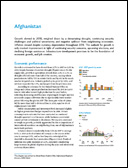Wednesday 3 April 2019
Infrastructure Development Key to Afghanistan’s Growth
KABUL (ADB press service) — Focusing on infrastructure development will help bring about long-term growth in Afghanistan and address persistent issues affecting the country’s economic prospects, apart from security, including poor connectivity, poor access to limited energy supply, and low agriculture productivity, says a new Asian Development Bank (ADB) report.
In its Asian Development Outlook (ADO) 2019, ADB forecasts Afghanistan’s economy to grow by 2.5% in 2019 and 3.0% in 2020, from the 2.2% growth rate in 2018 on the back of drought, security and political challenges, as well as negative spill over from neighbouring countries. ADO is ADB’s flagship annual economic publication.
“Better infrastructure can strengthen economic growth, enlist improved mobility to energize commerce and agriculture, and boost government revenues available for development spending”, said ADB Country Director for Afghanistan Mr. Samuel Tumiwa. “ADB is proud to be Afghanistan’s leading development partner in infrastructure development and regional cooperation, and remains committed to support the country build the needed infrastructure for poverty reduction.”

Pick up in the agriculture sector due to better weather conditions is expected in 2019. Inflation will accelerate to 3.0% in 2019 and 4.5% in 2020 with the lagged impact of 2018 currency depreciation and further depreciation expected in 2019 and 2020 as inflows of assistance slow. However, food prices are expected to remain low as agriculture recovers.
Domestic revenue is estimated to have reached 11.7% of gross domestic product (GDP) in 2018 due to enhanced tax administration and compliance, as well as measures against corruption in the customs department. Foreign aid comprised 56.3% of budget revenue, or 15.1% of GDP, to bring total revenue and grants to the equivalent of 26.4% of GDP.
The Afghanistan Living Conditions Survey, conducted in 2016 and 2017, revealed that only 36% of the population has access to safe drinking water nationally, only 31% of the population is connected to the electric grid, and only 63% of the rural population lives within 2 km of an all-season road, and road density is estimated at a low 15 km per 100 km² of territory, which is below the densities achieved by Afghanistan’s neighbours.
Some of the measures to enhance infrastructure development, according to the report, include a coordinated government approach to implement ongoing construction projects and upgrade its capacity in the design, implementation, and monitoring of investment projects. The government needs to address skills shortages and stimulate private sector investment in infrastructure development.
In addition, the government needs to seek sustainable infrastructure financing and look at innovative approaches to increase access to funding. Financing needed for the National Infrastructure Plan, 2017–2021, of about $1 bln annually exceeds available resources from development partners and domestic fiscal resources for new investment are limited.


